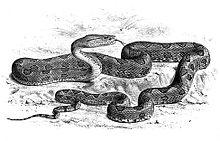- Trimeresurus mucrosquamatus
-
Trimeresurus mucrosquamatus 
Scientific classification Kingdom: Animalia Phylum: Chordata Subphylum: Vertebrata Class: Reptilia Order: Squamata Suborder: Serpentes Family: Viperidae Subfamily: Crotalinae Genus: Trimeresurus Species: T. mucrosquamatus Binomial name Trimeresurus mucrosquamatus
(Cantor, 1839)Synonyms - Trigonocephalus mucrosquamatus - Cantor, 1839
- Trimeresurus mucrosquamatus - Günther, 1864
- Crotalus Trimeres[urus]. mucrosquamatus - Higgins, 1873
- Lachesis mucrosquamatus - Boulenger, 1896
- Trimersurus mucrosquamatus - Taub, 1964
- P[rotobothrops]. mucrosquamatus - Hoge & Romano-Hoge, 1983
- Trimeresurus mucrosquamatus - Zhao & Adler, 1993[1]
Trimeresurus mucrosquamatus is a venomous pitviper species found from India (Assam) and Bangladesh, to Myanmar, China and Taiwan. No subspecies are currently recognized.[4]
Contents
Description
Males grow to a maximum total length of 112 cm with a tail length of 19.5 cm. Females grow to a length of 116 cm with a tail length of 20.5 cm. In the males, the hemipenes are spinose.[5]
Scalation: dorsal scales in 25 longitudinal rows at midbody; scales on upper surface of head, small, each scale keeled posteriorly; internasals 5-10 times size of adjacent scales, separated by 3-4 scales; supraoculars, long, narrow, undivided, 14-16 small interoculars in line between them; 2 scales on line between upper preocular and nasal scale; 9-11 upper labials, first upper labial separated from nasal by suture; 2-3 small scales between upper labials and subocular; 2-3 rows of temporal scales above upper labials smooth, above those scales keeled; ventrals 200-218; subcaudals 76-91, all paired.[5]
Color pattern: grayish or olive brown above, with dorsal series of large brown, black-edged spots or blotches, and a lateral series of smaller spots; head above brownish, below whitish; belly whitish but heavily powdered with light brown; tail brownish (possibly pink in life [fide Smith 1943:507]), with series of dark dorsal spots.[5]
Common names
Brown spotted pitviper,[2] pointed-scaled pit viper, habu,[3] Taiwan habu, Chinese habu, Formosan pit viper.[6]
Geographic range
Found from northeastern India (Assam) and Bangladesh to Myanmar, China (Fukien, Kwangshi, Kwantung and Szechwan), as well as in Taiwan. The type locality given is "Naga Hills" (Assam, India).[1]
See also
- List of crotaline species and subspecies
- Trimeresurus by common name
- Trimeresurus by taxonomic synonyms
- Crotalinae by common name
- Crotalinae by taxonomic synonyms
- Snakebite
References
- ^ a b McDiarmid RW, Campbell JA, Touré T. 1999. Snake Species of the World: A Taxonomic and Geographic Reference, vol. 1. Herpetologists' League. 511 pp. ISBN 1-893777-00-6 (series). ISBN 1-893777-01-4 (volume).
- ^ a b Gumprecht A, Tillack F, Orlov NL, Captain A, Ryabov S. 2004. Asian Pitvipers. GeitjeBooks Berlin. 1st Edition. 368 pp. ISBN 3-937975-00-4.
- ^ a b U.S. Navy. 1991. Poisonous Snakes of the World. US Govt. New York: Dover Publications Inc. 203 pp. ISBN 0-486-26629-X.
- ^ "Trimeresurus mucrosquamatus". Integrated Taxonomic Information System. http://www.itis.gov/servlet/SingleRpt/SingleRpt?search_topic=TSN&search_value=634926. Retrieved 25 May 2007.
- ^ a b c Leviton AE, Wogan GOU, Koo MS, Zug GR, Lucas RS, Vindum JV. 2003. The Dangerously Venomous Snakes of Myanmar, Illustrated Checklist with Keys. Proc. Cal. Acad. Sci. 54 (24): 407-462.
- ^ Brown JH. 1973. Toxicology and Pharmacology of Venoms from Poisonous Snakes. Springfield, Illinois: Charles C. Thomas. 184 pp. LCCCN 73-229. ISBN 0-398-02808-7.
Further reading
- Boulenger, George A. 1890 The Fauna of British India, Including Ceylon and Burma. Reptilia and Batrachia. Taylor & Francis, London, xviii, 541 pp.
- Cantor, T. E. 1839 Spicilegium serpentium indicorum [parts 1 and 2]. Proc. Zool. Soc. London, 7: 31-34, 49-55.
- Gumprecht, A.; Tillack, F.; Orlov, N.L.; Captain, A. & Ryabow, S. 2004 Asian Pit Vipers. Geitje Books, Berlin, 368 pp.
- Kraus, Fred; Mink, Daniel G. & Brown, Wesley M. 1996 Crotaline intergeneric relationships based on mitochondrial DNA sequence data. Copeia 1996 (4): 763-773
- Tu, M.-C. et al. 2000 Phylogeny, Taxonomy, and Biogeography of the Oriental Pit Vipers of the Genus Trimeresurus (Reptilia: ViperidaCrotalinae): A Molecular Perspective. ZOOLOGICAL SCIENCE 17: 1147-1157
External links
- Protobothrops mucrosquamatus at the Reptarium.cz Reptile Database. Accessed 6 December 2007.
- Protobothrops mucrosquamatus at Uetz Lab. Accessed 6 December 2007.
Categories:- Trimeresurus
- Fauna of Taiwan
- Fauna of Vietnam
- Fauna of India
Wikimedia Foundation. 2010.
